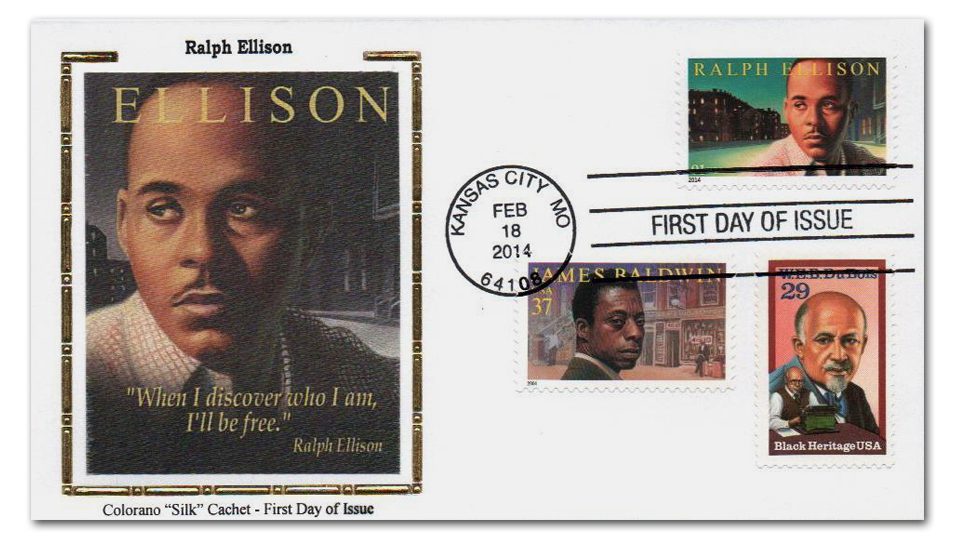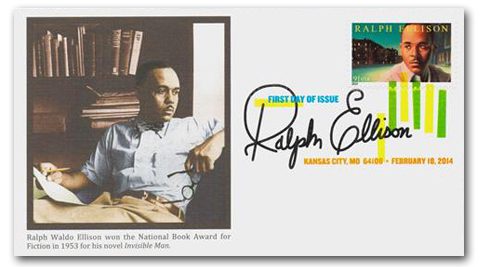
Ralph Waldo Ellison was born on March 1, 1913, in Oklahoma City, Oklahoma. A self-proclaimed Renaissance Man, Ellison was a talented musician and writer, most famous for his novel, Invisible Man.
Ellison was named by his book-loving father for poet Ralph Waldo Emerson. In fact, in later years, Ellison learned that his father, who died in 1916, hoped Ralph would grow up to become a poet. Young Ralph inherited a lifelong fondness for literature.
While still young, Ellison was a self-proclaimed Renaissance man. His wide-ranging interests included music, sculpting, constructing audio equipment, and writing. He got free music lessons on the trumpet and saxophone and was his school’s bandmaster. Ellison also helped support his family working as a busboy, shoeshine boy, hotel waiter, and dental assistant.
Ellison applied to the prestigious Tuskegee Institute twice, and was finally admitted in 1933 because the school orchestra needed a trumpet player. Ellison was disappointed in how class-conscious the school was and felt like an outsider. However, he enjoyed spending his free time in the library, where he eventually worked as a desk clerk. He read the works of James Joyce and Gertrude Stein and said that T.S. Eliot’s The Waste Land was a major inspiration. Ellison was also largely influenced by his English teacher Morteza Drezel Sprague, who helped him see “the possibilities of literature as a living art.”
In 1936, Ellison moved to New York City to study sculpture. He quickly met Langston Hughes, Romare Bearden, and Richard Wright. After working for the Federal Writers Project and submitting book reviews, Ellison was encouraged to pursue a career as an author. Along with Wright, he became associated with Communist Party, but left it during World War II. He then began writing his most famous novel, Invisible Man, as a response to what he saw as the party leadership’s betrayal of African Americans.
Published in 1952, Invisible Man dealt with issues of racial prejudice and the search for personal identity. A new type of black character was introduced, a man who was educated and well spoken. In the book, the narrator calls himself invisible because “people refuse to see” him. Invisible Man won the National Book Award in 1953. In his acceptance speech, he said he felt he had made “an attempt at a major novel” and was unsatisfied with the book. Invisible Man was Ellison’s only novel published during his lifetime and the mark left by it continues to be felt in literature and throughout American culture.

Ellison went on to write many significant essays, which he collected in Shadow and Act in 1964. He also taught at Bard College, Rutgers University, and Yale University. Ellison spent a considerable amount of time working on another novel, writing over 2,000 pages. More than 300 pages of it were destroyed in a 1967 fire and he never finished it during his lifetime. He died from pancreatic cancer on April 16, 1994. His second novel, Juneteenth, was published posthumously in 1999.
During his career, Ellison was admitted to the American Academy of Arts and Letters, received two President’s Medals and a State Medal from France. He also received the Langston Hughes Medal and the National Medal of Arts. The New York Times once proclaimed him “among the gods of America’s literary Parnassus.”
| FREE printable This Day in History album pages Download a PDF of today’s article. Get a binder or other supplies to create your This Day in History album. |
Discover what else happened on This Day in History.






Great Information beyond the stamp itself. What a great writer but yet still unknown in American History.